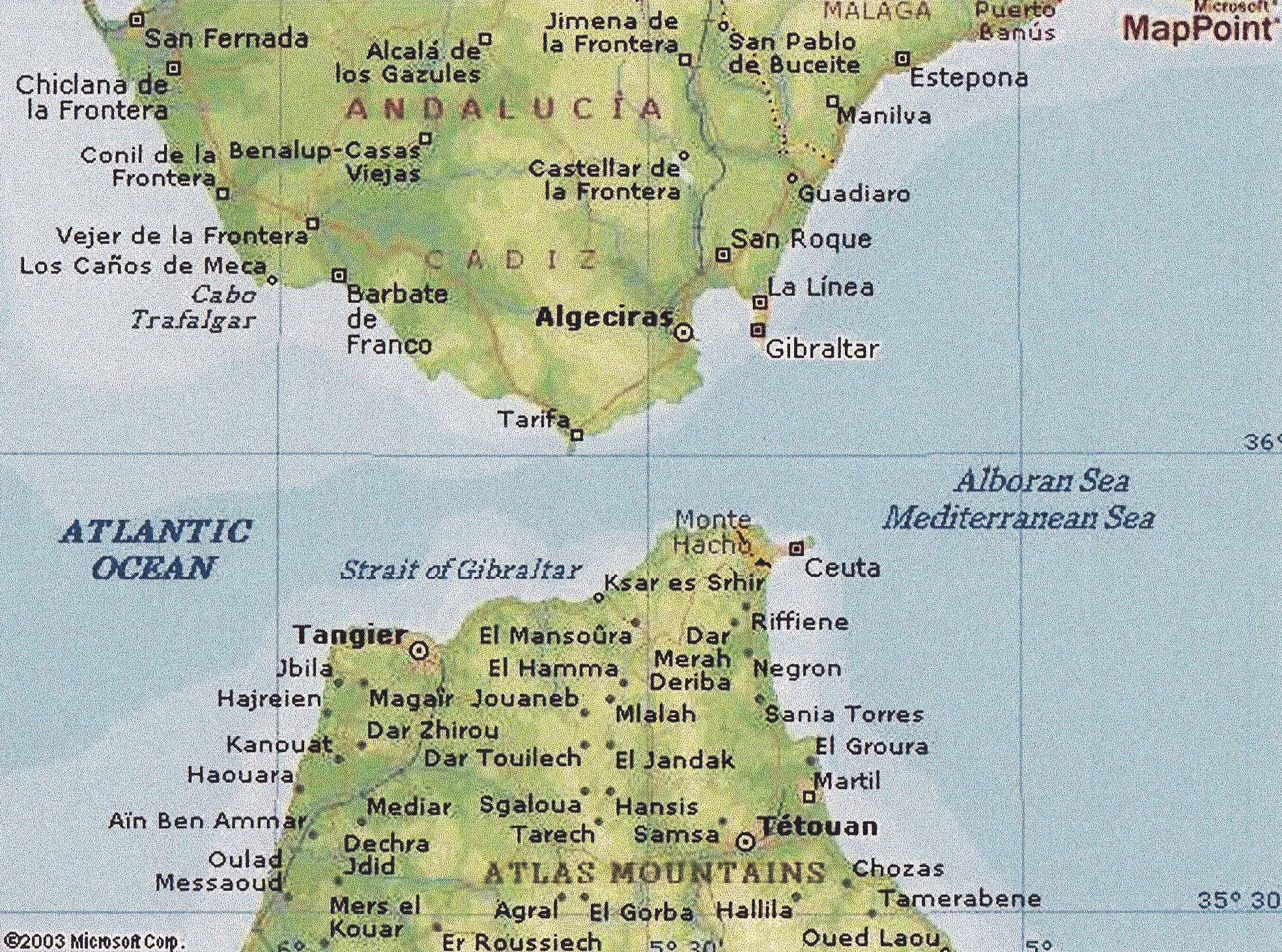
16151 Engineer
Clerk Staff Sergeant
FRANK ARTHUR HARRINGTON STILES
Royal Engineers
by
Lieutenant Colonel Edward De Santis
© 2017. All Rights Reserved
This research dealing with Staff Sergeant Stile’s military service has
been compiled primarily from his military service papers obtained from the
National Archives in the United Kingdom. Where
other sources have been used, these sources have been noted in the Reference
section at the end of this biographical narrative.
Early Life and Enlistment
Frank Arthur Harrington Stiles was born in August of 1854 in London,
Middlesex County, Ontario, Canada. He
was the son of John Edgar and Evelyn Stiles of London, Ontario.
Frank enlisted for service in the Royal Engineers at Pembroke Dock in
South Wales on the 12th of November 1878.
He was recruited by Quartermaster Sergeant H. Saunders, R.E. at 10:30
A.M. on this date. How and why he
got to England from Canada is not known.
At the time of his enlistment Frank was 24 years and 3 months of age.
On his attestation documents he indicated that he was a Clerk by trade
and that he was not an Apprentice. He
was single and had not had any prior service in Her Majesty’s forces nor had
he ever been rejected for service in the Royal Navy or the Army.
He enlisted for a period of 12 years without a bounty and indicated that
he would be willing to serve for an additional period of 12 years if abroad.[1]
Stiles’ Medical Certificate on Enlistment was approved by Surgeon Major
H. Kelsall at Pembroke Dock on the day of his enlistment and Colonel W.
Phillpotts, R.E., Commander Royal Engineers (C.R.E.) in South Wales signed the
Certificate of Superintending Officer for his enlistment.[2]
On his attestation document Frank Stiles listed his parents and his
brother, George Frederick Stiles, as his next of kin, all of London, Ontario,
Canada.
Stiles swore the Oath of Attestation, with Special Authority[3]
on the 13th of November 1878 at Pembroke Dock at 4 P.M. with
Quartermaster Sergeant Saunders present as a witness.
The oath was administered by Justice of the Peace Thomas McMaster.
On the 21st of November 1878 the Certificate of Approving
Field Officer for his enlistment was signed by Colonel Charles S. Aker, R.E.
On this day he joined the ranks as a Sapper, Regimental Number 16151,
although his service reckoned from the 13th of November.
Stiles’ Description on Enlistment form contained the following
information:
|
Apparent
age: |
24
years. |
|
Height: |
5
feet 11¼ inches. |
|
Chest
measurement: |
3
feet 1 inch. |
|
Complexion: |
Fair. |
|
Eyes: |
Blue. |
|
Hair: |
Light
brown. |
|
Distinctive
marks: |
None. |
|
Religion: |
Church of England. |
Stiles
description at the time of his discharge from the Army was as follows:
|
Apparent
age: |
46
years and 6 months. |
|
Height: |
6
feet. |
|
Chest
measurement: |
42
inches. |
|
Complexion: |
Fair. |
|
Eyes: |
Blue. |
|
Hair: |
Brown. |
|
Distinctive
marks: |
None. |
|
Trade: |
Clerk. |
Very little medical information is contained in the records of Frank
Stiles during his time in the Army except that he was admitted to the Royal
Hospital at Chelsea, London on the 19th of February 1901 for an
undisclosed ailment or more likely for a medical examination in conjunction with
his discharge from the Army.[5]
Frances Stiles would have five children before Frances dies in 1917.
In addition to Frank having Harrington as one of his middle names, all
three of his sons would be given the additional middle name of Harrington.
Searches through census
records
in both England and Canada did not produce any connection between the family
name Stiles and the family name Harrington.
Table
1. Dates and Places of Birth of the
Children of Frank and Frances Stiles.
|
Child’s Name |
Date of Birth |
Place of Birth |
|
Carrie
Louisa Evelyn |
1
November 1888 |
Old
Brompton, Kent |
|
Gwendoline |
5
November 1891 |
Gibraltar |
|
Frank
Ernest Harrington[7] |
29
August 1894 |
Gibraltar |
|
Emily |
1
December 1896 |
Gibraltar |
|
George
Edgar Harrington |
8
July 1902 |
Farnborough,
Hampshire |
|
Frederick
Henry Harrington |
2
September 1904 |
Farnborough,
Hampshire |
Promotions:
|
Dates of Promotion |
Rank |
|
13
November 1878 |
Appointed
Sapper on enlistment |
|
31
March 1881 |
Appointed
Unpaid Lance Corporal |
|
1
July 1881 |
Appointed
Paid Lance Corporal |
|
30
September 1881 |
Promoted
2nd Corporal |
|
1
May 1883 |
Promoted
Corporal |
|
15
November 1885 |
Promoted
Sergeant |
|
7
July 1888 |
Reduced
by court martial to the rank of Sapper |
|
7
July 1889 |
Returned
to duty as a Sapper after one year of imprisonment. |
|
7
May 1891 |
Appointed
Lance Corporal. |
|
2
January 1897 |
Promoted
Sergeant |
|
2
January 1900 |
Promoted
Engineer Clerk Staff Sergeant |
Conduct:
Stiles service papers
do not indicate that he received the Long Service and Good Conduct Medal for his
service. The original award of this
medal in 1830 was for soldiers of “exemplary conduct” for 21 years in the
infantry and corps and 24 years in the cavalry. In 1870 this period was reduced
to 18 years for all soldiers. This was done partially so that the medal could be
worn by a soldier before his discharge to show off his example of
‘exemplary’ service to the other men of his unit and the army.
Since Stiles had enlisted in 1878, he would have been entitled to the
medal after 18 years of service; that is, in 1896.
However, as he was tried by court martial and sentenced to imprisonment
in his 10th year of service, he was not authorized to receive the
Long Service and Good Conduct Medal, although he had been awarded four Good
Conduct Badges.[8]
Table 3.
Summary of the Conduct of Frank Arthur Harrington Stiles.
|
Date of Award |
Offenses, Good Conduct Badges and Pay |
|
13
November 1880 |
Awarded
Good Conduct Pay at 1d per day.[9] |
|
13
November 1884 |
Awarded
Good Conduct Pay at 2d per day. |
|
29
May 1888 |
Absent without leave for 10 days and probably in
pre-trial confinement awaiting trial on the 8th of June 1888. |
|
6-7
July 1888 |
Tried by District Court Martial (see note below).
He was convicted of forgery, embezzlement, making fraudulent
statements and absence without leave.
He was reduced to the ranks and sentenced to 2 years at hard
labour with one year of the sentence being remitted. |
|
8
July 1888 |
Forfeited
1d of 2d Good Conduct Pay.
|
|
6
July 1889 |
Released
from prison. Returned to
duty as a Sapper. |
|
7
July 1890 |
Restored
Good Conduct Pay at 2d per day one year after release from
prison. |
|
7
July 1892 |
Awarded
Good Conduct Pay at 3d per day. |
|
12
November 1896 |
Awarded
Good Conduct Pay at 4d per day. |
NOTE: A
District Court Martial was intended to adjudge more serious charges, and was
convoked by the commander of a brigade or military district.
The president of the court martial had to be, if possible, a field grade
officer and the
members, four or at least two, had to be officers from different corps,
and must have served at least two years as such.
The District Court Martial was authorized to sentence the accused soldier
to imprisonment with or without hard labour for a period not exceeding two
years, or could inflict lighter punishments.
Expulsion from the service also could be decreed.
The sentence of the court martial had to be confirmed by the commander of
the district or brigade.
Table 4.
Certificates of Education Awarded to Frank Arthur Harrington Stiles.[10]
|
Date |
Education |
|
11
February 1879 |
Awarded
a 2nd Class Certificate of Education. |
|
31
October 1893 |
Awarded
a 1st Class Certificate of Education. |
Home
Service
Following
his enlistment Sapper Stiles was sent to the School of Military Engineering at
Chatham, Kent for training as an engineer soldier.[11]
From his service papers it appears that he remained at Chatham and served
in either the Training Battalion or the Depot Battalion of the Royal Engineers
for a considerable period of time.
On the 22nd of October 1886 he extended his service[12]
and consented to serve under Part II of the Army Discipline and Regulation (A.D.
& R.) Act of 1879[13]
with his service being re-assessed in accordance with Section 192(5) of the Army
Act of 1881.[14]
In July of 1888, Stiles then a Sergeant, was absent without leave for a
period of 10 days and was subsequently court martialed for his offense.
In addition to being absent he apparently committed forgery, embezzlement
and made fraudulent statements, for which he was reduced to the rank of Sapper
and served one year of imprisonment at hard labour (see Section 6 above under
Conduct). Unfortunately his military
records do not give any details of his offenses, but they apparently had to do
with his need for money and an attempt by him to gain this money through illegal
acts. He was married at the time and
his wife was pregnant with their first child, a daughter born only four months
after his imprisonment. Life for his
wife and their infant daughter must have been hard while he served his term of
imprisonment. He actually had been
sentenced to two years imprisonment, but one year had been remitted.
It is possible that the court martial board considered his wife’s
condition when passing sentence.
Upon his release from prison Stiles returned to duty as a Sapper and on
the 26th of July 1890 he re-engaged to complete 21 years of service.[15]
On Christmas Day 1890 he and his family departed England for duty at
Gibraltar.
Gibraltar
It is difficult to determine to which unit Stiles may have been assigned
at Gibraltar. When he arrived there
four companies were serving on “The Rock.”
These included:
6th
Field Company (from 1887 to 1899)
15th
Field Company (from 1884 to 1898)
20th
Fortress Company (1887 to 1899)
32nd
Fortress Company (1890 to 1898)
There
is no notation in his Statement of Services to indicate in which unit he served.
The only clue to his unit is the name of the officer who made entries in
his service record during the time that Stiles was at Gibraltar.
That officer was Captain Harry Balfour Jones, R.E.[16]

Figure 1. Gibraltar.
Stiles Served at Gibraltar from December 1890 to September 1897.
Home
Service
On the 21st of September 1897, then Sergeant Stiles, his wife
and three children, arrived home in England where he would serve for two years
before being posted abroad again. On
the 29th of April 1898 he elected to come under the Royal Warrant on
messing allowance dated 2 April 1898.[17]
Once again, during his almost two years of service in the United Kingdom
his unit is not indicated on his Statement of Services; therefore, his physical
location and the nature of his duties could not be determined during this
period. Entries in his Statement of
Services made by officers might have provided hints as to his unit, but
unfortunately the signatures of the officers are illegible as was often the case
with soldiers’ service papers.
South
Africa
Sergeant Stiles departed England on the 14th of November 1899
for service in the Second Boer War in South Africa.
He served in the Cape Colony and was present at the Battles of Paardeberg,
Driefontein and Johannesburg.
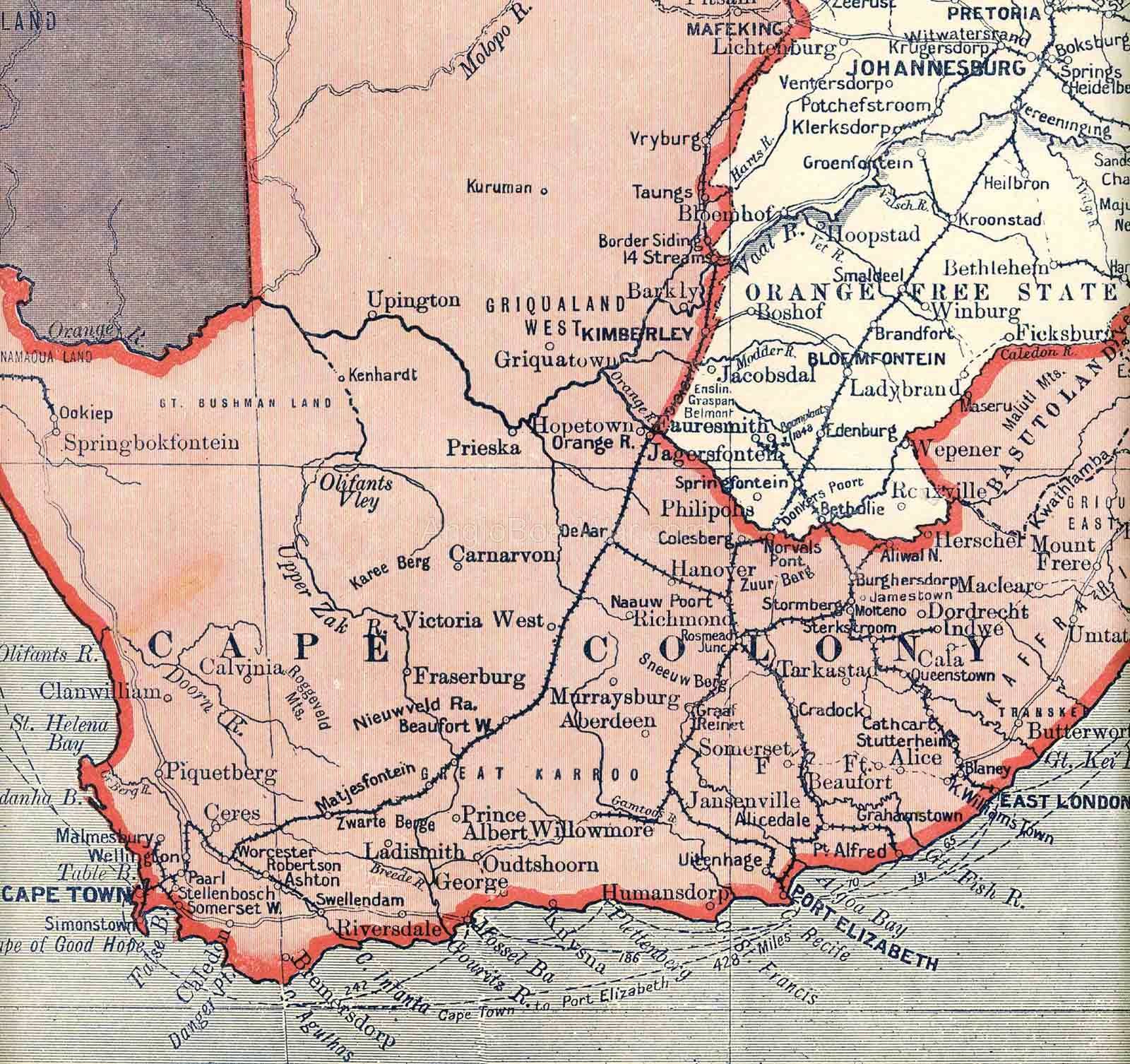
Figure 2. The Seat of the Second Boer War in the Cape
Colony and Orange Free State.
The Battle of Paardeberg[18] was a major battle during the Second Anglo-Boer War. It was fought near Paardeberg Drift on the banks of the Modder River in the Orange Free State near Kimberley.
Lord Methuen advanced up the railway line in November 1899 with the objective of relieving the besieged city of Kimberley (and the town of Mafeking, also under siege). Battles were fought on this front at Graspan, Belmont, and Modder River before the advance was halted for two months after the British defeat at the Battle of Magersfontein. In February 1900, Field Marshal Lord Roberts assumed personal command of a significantly reinforced British offensive.
The army of Boer General Piet Cronjé was retreating from its entrenched position at Magersfontein towards Bloemfontein after its lines of communication were cut by Major General John French, whose cavalry had recently outflanked the Boer position to relieve Kimberley. Cronjé's slow-moving column was intercepted by French at Paardeberg, where the Boer general eventually surrendered after a prolonged siege, having fought off an attempted direct assault by Lieutenant General Horatio Kitchener.
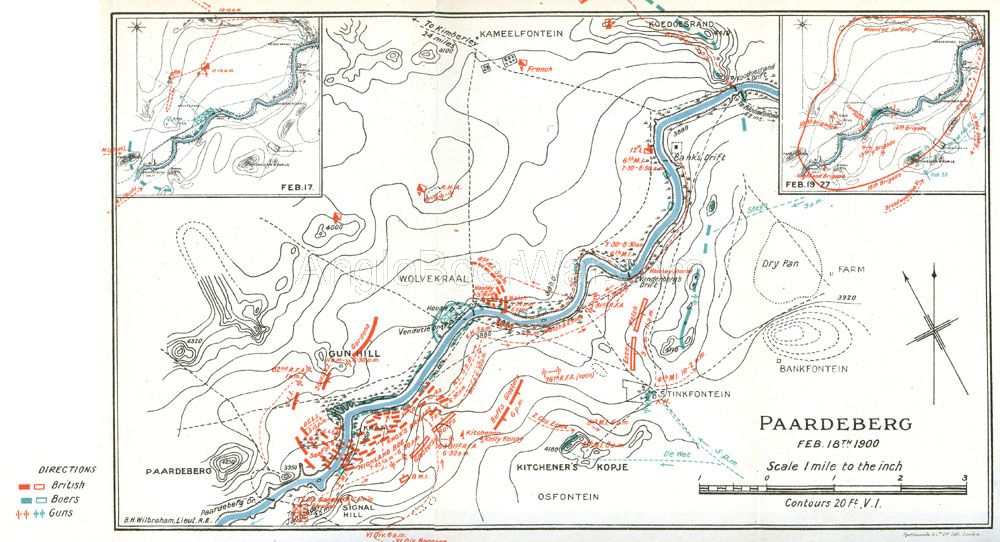
Figure 3. The Battle of Paardeberg, 18 February 1900.
The Battle of Driefontein[19] on 10 March 1900 followed on the Battle of Poplar Grove. In the first half of 1900, the British made an offensive towards the two Boer republic capitals of Bloemfontein and Pretoria. The Boer forces under the command of Christiaan de Wet were holding a 7-mile (11 km) line covering the approach to Bloemfontein. Lord Roberts subsequently ordered a division under Lieutenant General Thomas Kelly-Kenny to attack the position from the front, while Lieutenant General Charles Tucker's division moved against its left flank. The Boers were subsequently forced to withdraw losing 100 men, while the British lost 424.
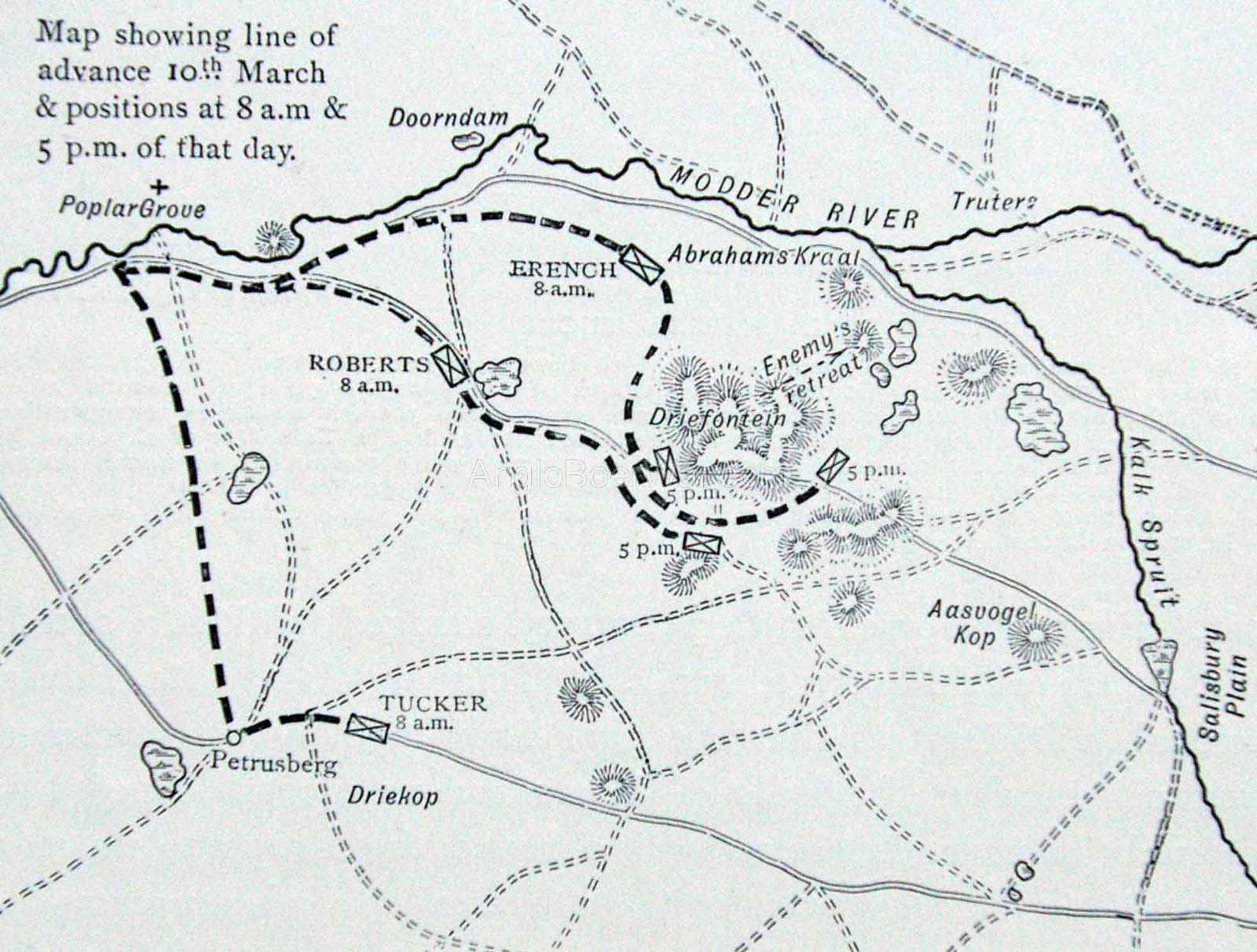
Figure 4. The Battle of Driefontein, 10 March 1900.
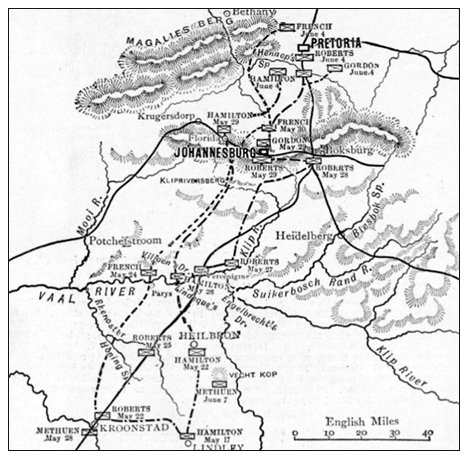
Figure 5. British Operations around Johannesburg.
Stiles’ Queen’s South Africa Medal includes the clasps [CAPE COLONY] [PAARDEBERG] [DRIEFONTEIN] and [JOHANNESBURG]. What is stated in his service papers is that he took part in Lord Roberts’ march from Enslin to Pretoria. On the 2nd of January 1900, only a month and a half after he left England, Stiles was promoted to the rank of Engineer Clerk Staff Sergeant. Presumably, this promotion took place in South Africa. His discharge papers indicate that he was a Clerk on the staff of the Engineer in Chief in South Africa, General Sir Elliott Wood, K.C.B., during his time on active service. In this staff position he probably would not have been actively engaged in field operations during the battles; that is, he would not have been at the “sharp end” of the action. However, his presence on the staff of the Engineer in Chief of Lord Roberts Army did earn him these clasps.
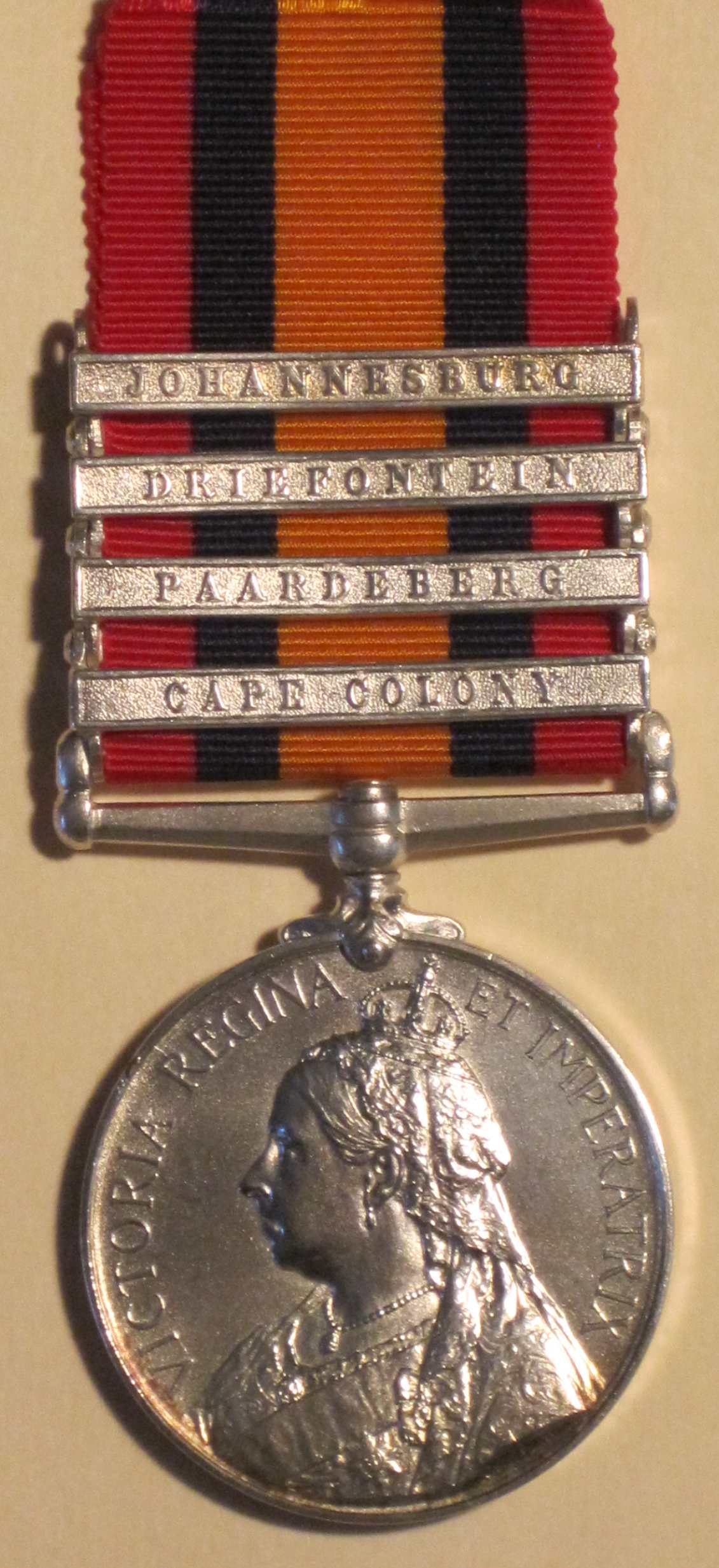
Figure 6. The
Queen’s South Africa Medal Awarded to 16151 Sergeant
F.A.H. Stiles, Royal Engineers[20]
Discharge
Stiles service papers indicate that on the 6th of February
1901 his Soldier’s Book was examined and correctly balanced and he indicated
in writing that he had received all pay, allowances and clothing that were due
him. He was discharged at Aldershot
on the 12th of February 1901 in consequence of the termination of his
second period of engagement in the Army. His
service towards his engagement was reckoned at 22 years and 92 days and his
service towards his pension at 21 years and 53 days.
He had lost over a year’s time towards his pension as a result of his
being imprisoned as a result of his court martial. The table below provides a
summary of his service.
Table 5. Summary of Service of Engineer Clerk Staff
Sergeant Stiles.
|
Country |
From |
To |
Total Time |
|
Home |
13
November 1878 |
24
December 1890 |
12
years & 42 days |
|
Gibraltar |
25
December 1890 |
20
September 1897 |
6
years & 270 days |
|
Home |
21
September 1897 |
13
November 1899 |
2
years & 54 days |
|
South
Africa |
14
November 1899 |
14
December 1900 |
1
year & 31 days |
|
Home |
15
December 1900 |
12
February 1901 |
60
days |
|
Total Service
at Home: |
14
years & 156 days |
||
|
Total Service
Abroad: |
7
years & 301 days |
||
|
Total
Service: |
22
years & 92 days |
||
At the time of his discharge, Staff Sergeant Stiles indicated that his
intended place of residence would be 5 Queen’s Terrace, Queen’s Road, in
Farnborough, Hampshire.
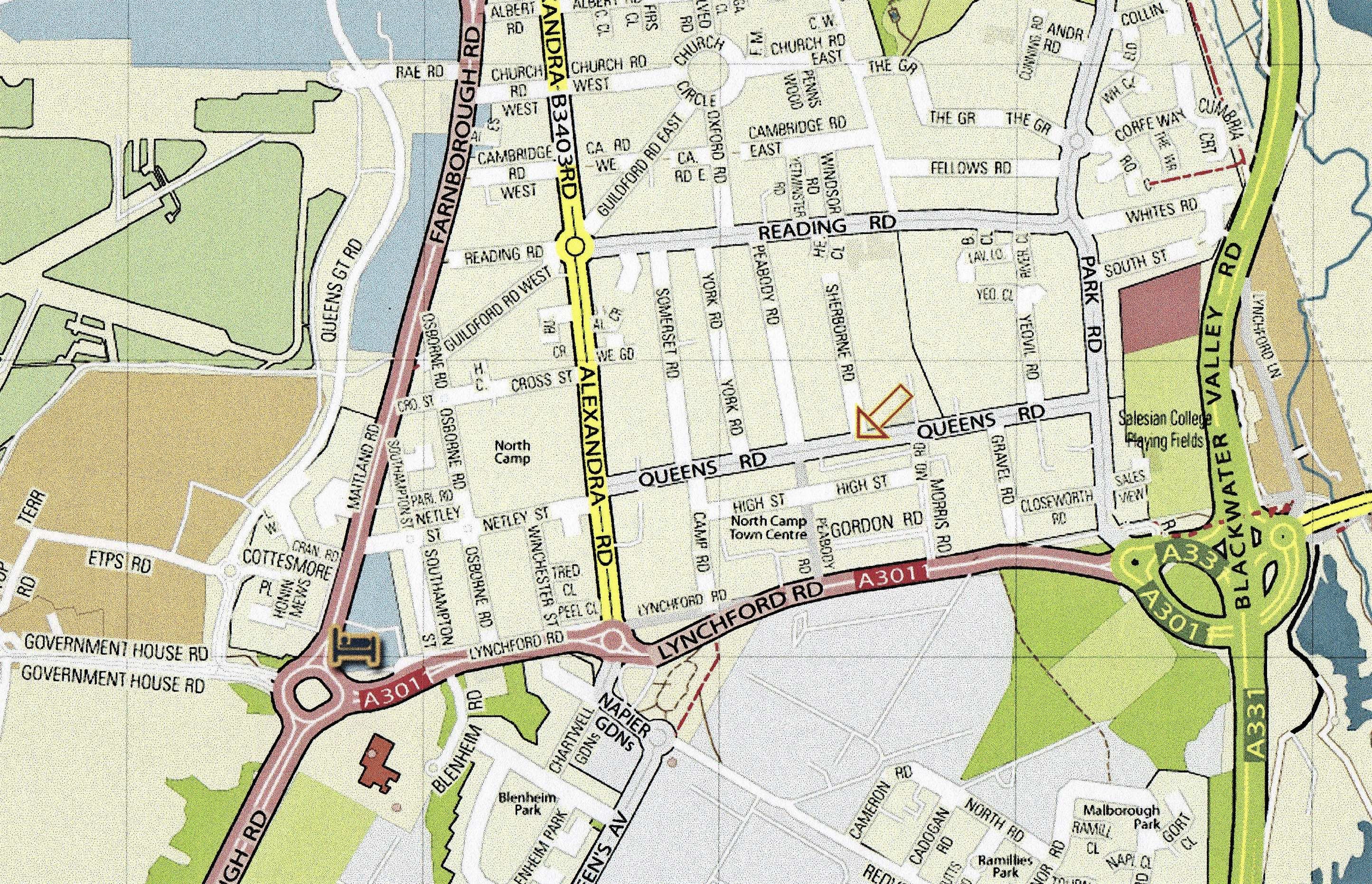
Figure 7. Queen’s Road and Southampton Street,
Farnborough, Hampshire.
It
may have been Stiles’ intention to reside at the Queen’s Road address when
he left the Army, and indeed he may have for a short period of time.
However, the family appears to have settled into an address on
Southampton Street just to the west of Queen’s Road (two blocks west of North
Camp) within three years after his discharge.
Post Service Life
Frank Arthur Harrington Stiles and his family were living on Southampton
Street in Farnborough, Hampshire in 1904 when his son Frederick was born.
Frank Stiles was employed as a Superintendant with the B.H. Assurance
Corporation. When his son Frank
Ernest enlisted in the Royal Engineers in 1908, he joined up in Dublin, Ireland.[22]
It is not clear from Frank Ernest’s service papers whether the entire
Stiles family was living in Dublin at that time or whether he was living there
alone or with another family.
Frank’s wife, Frances Louisa Stiles, died in 1917 (age about 45 years)
and was buried at the Victoria Road Cemetery in Farnborough, Hampshire.[23]
It might be assumed, therefore, that Frank and Frances may have moved
from Ireland back to Farnborough sometime between 1908 and 1917, if in fact they
ever went to Ireland.
The
Stiles Children
George Edgar Harrington Stiles lived at 33 Bendemeer Road, Putney,
Wandsworth, London from 1933 to 1938. He
died in December 1972 at Stoke-on-Trent, Staffordshire, age 70 years.
Frederick Henry Harrington Stiles died in March of 1973, age 69.
His lived in Westminster, London at the time of his death.
Frank Ernest Harrington Stiles died on the 3rd of April 1978,
age 84. His residence at the time of
his death was 110 Croxted Road, London, SE21.
His will was probated on the 19th of July 1978 at Brighton.
Frank Ernest left an estate valued at £11,411.
No trace could be found of either Gwendoline or Emily Stiles as they
probably had married and searches for them on genealogical web sites could not
be made without knowing their married names.
6.
SKELLEY, A.R.
The Victorian Army at Home: The
Recruitment and Terms and Conditions of the British Regular, 1859-1899.
McGill-Queen’s University Press, Montreal, 1977, pp. 237-238.
Internet Web Sites
1.
Surrey,
England, Church of England Baptisms, 1813-1912 for George Edgar
Harrington Stiles, South Farnborough, St
Mark, 1899-1907.
4.
Frederick Henry H. Stiles, Surrey,
England, Church of England Baptisms, 1813-1912.
7.
Frederick Henry H. Stiles, England
& Wales, Civil Registration Death Index, 1916-2007.
Soldier’s
Service Papers
1.
Proceeding on Attestation (War Office Form W.O. 498).
2. Description on Enlistment.
3. Statement of Services.
4.
Military History Sheet.
5.
Proceedings on Discharge (Army Form B. 268).
ENDNOTES
[2] The author has in his personal library a copy of the Roll of officers in the Corps of the Royal Engineers compiled by Captain TWJ Connolly, R.E. that once belonged to Colonel Phillpotts.
[3] The author has not been able to determine why “Special Authority” was required for his attestation.
[4] See AGE AND PHYSICAL REQUIREMENTS FOR SOLDIERS IN THE CORPS OF ROYAL ENGINEERS (VICTORIAN PERIOD).
[7] Frank Ernest Harrington Stiles also served in the Royal Engineers during the Great War of 1914-1918.
[8] Larimore, F.B. 2017. An author and authority on the Long Service and Good Conduct Medal issued by the British Army.
[9] See GOOD CONDUCT PAY.
[13] This was an Act that resulted in changes to punishments that could be administered to British soldiers.
[14] The Army Act of 1881 was the culmination of a process of inquiry and was intended to reform and modernize British military law. Yet it bore a closer relationship to earlier British models and to those of the old empires in Eastern Europe than it did to the more progressive ones in Western Europe. The Act outlined a total of twenty-seven capital offences – twelve were punishable by death at any time and fifteen were so punishable on active service only. These are summarized in the tables below (images from British Military Law and the Death Penalty (1868-1918). https://chs.revues.org/782):
Punishable
by Death
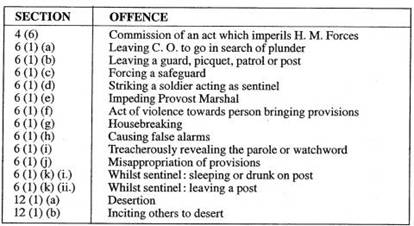

[15] See RE-ENGAGEMENT IN THE REGULAR ARMY.
[16] Later Colonel Harry Balfour Jones. Born 22 September 1866 the son of Major General Howell Locke Jones, Royal Artillery of 66 Kensington Park Road, London. Harry Balfour Jones attended Cheltenham College, graduating in July 1883. He died in 1952.
[17] Details regarding this messing allowance could not be found.
[18] Wikipedia: Battle of Paardeberg.
[19] Wikipedia: Battle of Driefontein.
[20] According to his service papers, this is the only medal awarded to Stiles during his time in the Army.
[21] See SUPERNUMERARY STAFF.
[22] Service papers of Frank Ernest Harrington Stiles.